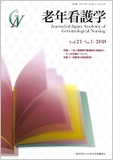Japanese
English
- 販売していません
- Abstract 文献概要
- 参考文献 Reference
抄録
本研究の目的は,下肢の整形外科高齢患者が療養環境に持ち込む特別な物とその意味を明らかにし,Csikszentmihalyiらの家庭にある特別な物とその意味分類との対比を行うことである.結果,本研究の研究対象者では,Csikszentmihalyiらの5カテゴリーと関連づけられた11の意味分類が抽出された.《精神的安定をもたらす物》として【思いやりを感じられる物】【癒しや励みになる物】【外部とのつながりをもてる物】の3つの意味分類,《家庭での生活を継続できる物》として【入院生活でも行える自宅で使い慣れた物】【睡眠を助ける物】【清潔を保てる物】【過去の入院から持ち続けた物】【手づくりの物】の5つの意味分類,《状況の把握と運動制限を補うための物》として【疼痛や可動域制限を補うための自助具】【体動制限時,物の位置や状況を把握できる物】【夜間,物の位置や時間を把握できる物】の3つの意味分類であった.以上より,入院時の準備段階から疾患や入院生活の特性に合わせた情報提供を行い,療養環境を整えるための看護支援を行う必要性が示唆された.
The purpose of this study was to examine the meaning of personal possessions brought to the hospital by elderly individuals undergoing orthopedic surgery of the lower limbs. Specifically, we sought to compare these possessions with semantic classification of “the meaning of things” as per the work of Csikszentmihalyi et al. pertaining to household items. We identified 11 semantic classifications associated with five categories as per Csikszentmihalyi et. al. There were three meaning classes including “things that incite compassion,” “things that help facilitate healing and are encouraging,” and “things that can have a connection with the outside” that were extracted as <things that bring mental stability>. Five meaning classes extracted as <things with which one's lifestyle can be continued at home> included “things that continue to be used during hospitalization,” “things that help one sleep,” “things that can help keep the body clean,” “things that have been retained from a prior hospitalization,” and “handmade things.” Finally, we extracted three meaning classes including “self-help tools for compensating for pain and restricted range of motion,” “things that help comprehend the position and situation of other things when body motion is restricted,” and “things that help comprehend the position and timing of things at night” as <things for understanding the situation and movement restrictions>. Our findings suggest that when preparing for hospitalization, information should be provided in accordance with the characteristics of illnesses and hospitalized living. Furthermore, nursing assistance for recuperative environments is important and should be provided.
Copyright © 2018, Japan Academy of Gerontological Nursing All rights reserved.


